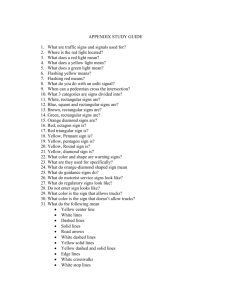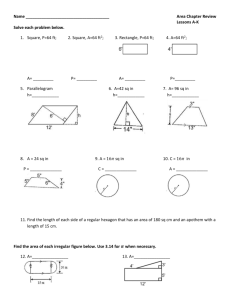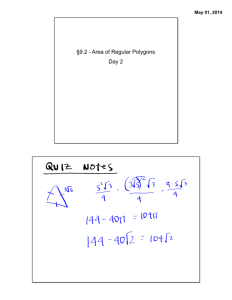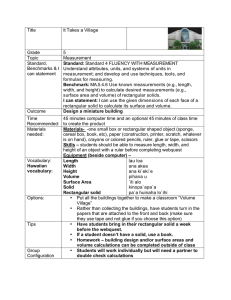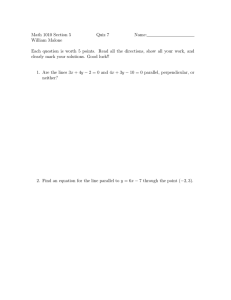TABLE OF CONTENTS
advertisement
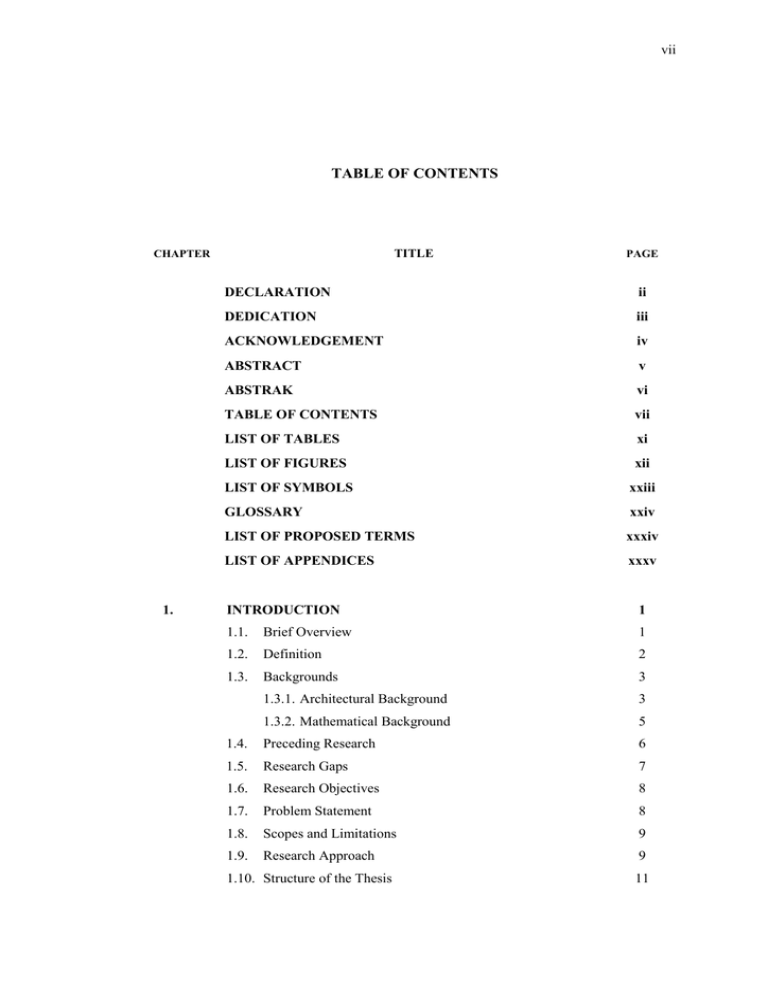
vii
TABLE OF CONTENTS
TITLE
CHAPTER
1.
PAGE
DECLARATION
ii
DEDICATION
iii
ACKNOWLEDGEMENT
iv
ABSTRACT
v
ABSTRAK
vi
TABLE OF CONTENTS
vii
LIST OF TABLES
xi
LIST OF FIGURES
xii
LIST OF SYMBOLS
xxiii
GLOSSARY
xxiv
LIST OF PROPOSED TERMS
xxxiv
LIST OF APPENDICES
xxxv
INTRODUCTION
1
1.1.
Brief Overview
1
1.2.
Definition
2
1.3.
Backgrounds
3
1.3.1. Architectural Background
3
1.3.2. Mathematical Background
5
1.4.
Preceding Research
6
1.5.
Research Gaps
7
1.6.
Research Objectives
8
1.7.
Problem Statement
8
1.8.
Scopes and Limitations
9
1.9.
Research Approach
9
1.10. Structure of the Thesis
11
viii
2.
3.
4.
SIGNIFICANCE OF THE CURRENT RESEARCH
13
2.1. Chapter Overview
13
2.2. The Nature of the Phenomenon
13
2.3. Why Study Star Polygon in the Context of Rasmi
14
2.4. Why Study Rasmi in the Context of Math
16
2.5. Chapter Summary
17
LOGICAL INDUCTIONS FROM ARCHITECTURAL DATA
18
3.1. Chapter Overview
18
3.2. Existing Revelations and Functions
18
3.2.1. Numbers by far Attempted
20
3.2.2. Established and Conventional Revelations
22
3.3. Rational Inductions and Questions That Arise
160
3.4. Statement of the Problem
162
3.5. Chapter Summary
163
STATE OF KNOWLEDGE
164
4.1. Chapter Overview
164
4.2. Introduction
164
4.3. Architectural Knowledge
165
4.3.1. Primary Knowledge
166
4.3.2. Design Research
167
4.3.3. The Persian Manuals
168
4.3.4. Manuscripts
169
4.3.5. Digital Design Modeling
171
4.3.5.1. M. Maleki and R. Woodbury (2008)
172
4.3.5.2. P. Rasouli and A. Bastanfard (2010)
172
4.3.6. Z. Bozorgmehri (1982 and 2006)
4.4. Mathematical Knowledge
173
176
4.4.1. Pre-Bradwardinian Research
176
4.4.2. Thomas Bradwardine (1290-1349)
177
4.4.3. Johannes Kepler (1571-1630)
180
4.4.4. Bernhard Riemann (1826-1866), and Ludwig Schläfli
(1814-1895)
4.4.5. Harold Scott Macdonald Coxeter (1907-2003)
4.4.6. Contemporary Research
4.5. Chapter Summary
181
181
182
183
ix
5.
6.
7.
DEFINITION OF SCOPES AND LIMITATIONS
185
5.1. Chapter Overview
185
5.2. Introduction
185
5.3. Scopes of the Research
186
5.3.1. Planar Aspects
187
5.3.1.1. The Number of Stellations
188
5.3.1.2. Rasmi Inscription
188
5.3.1.3. Bradwardine’s Reexamination
190
5.4. Limitations of the Research
190
5.5. Chapter Summary
191
RESEARCH DESIGN AND METHODOLOGY
192
6.1. Chapter Overview
192
6.2. Data Collection
192
6.2.1. Stage 1: Data Production
193
6.2.2. Stage 2: Data Processing
194
6.3. Formulation Circuit
195
6.4. Chapter Summary
199
MATHEMATICAL QUESTIONS AND THEIR ANALYSIS
200
7.1. Chapter Overview
200
7.2. Mathematical Explorations
201
7.3. Sum of the Internal Angles
204
7.4. Sequel, Density and Stellation
211
7.5. Revelation and Processes
214
7.5.1. Amputation
216
7.5.2. Inscription
217
7.6. Regular Revelation
218
7.6.1. Regular Inscriptions
218
7.6.2. Regular Inscriptional Arrangements
220
7.7. Semi-regular Revelation
225
7.7.1. Bilateral Symmetry
226
7.7.2. Biaxial Symmetry
226
7.7.3. Semi-regular Shapes
228
7.7.4. Rectangular Inscription
228
7.7.4.1.
Question 2.1
228
x
7.7.4.2.
Question 2.2
7.7.5. Trapezoidal Inscription
8.
229
234
7.8. Irregular Revelation
250
7.9. Chapter Summary
252
CONCLUSION
253
8.1. Summary of the Findings
254
8.2. Proposals for Future Research
261
REFERENCES
APPENDICES A.0 – A.12
264
268-299
xi
LIST OF TABLES
TABLE NO.
TITLE
PAGE
7.1.
Sum of the internal angles of rasmis 5 to 16, in reverse sequel
order
205
7.2.
The sum of internal angles of R15 and 16 in direct sequel order
207
7.3.
Number of -and correlations between- rectangular inscriptions
for even rasmis 20- 34
234
7.4.
Rasmis 5-28 divided into odd and even, with the respective
trapezoidal inscriptions
236
7.5.
The differences
inscriptions
239
7.6.
Segregation of doubly and singly even rasmis with the
pertinent trapezoidal inscriptions
241
7.7.
Singly even rasmis and their trapezoidal inscriptions
244
7.8.
Common denominator between R – 2 and the number of
trapezoids
244
7.9.
Incorporation of (R – 2)/4 into the correlations between
trapezoids and singly even rasmis
245
7.10.
Identification of correlations between trapezoids and (R–2)/4
246
and
correlations
between
trapezoidal
xii
LIST OF FIGURES
FIGURE NO.
TITLE
PAGE
2.1
Displaying kouné of 12 and its state as an amputated revelation
of R12
15
3.1
The two sixes of Guarini that remained as sketch
24
3.2
Visitation, Vallinotto (B. Vittone), cheshmé of 6
25
3.3
Wells Cathedral, cheshmé of 8.
26
3.4
Bib Mardoun, Toledo, cheshmé of 8
26
3.5
Cordova, the first known samples, cheshmés of {8/2} and {8/3}
27
3.6
Qubbat Barudyin, cheshmé of 8, with cusped profile
28
3.7
Italian samples. Top: San Lorenzo. Bottom: San Chiara, Bra
29
3.8
Ste Anne-la-Royale, Paris (G. Guarini),
30
3.9
Isfahan, Vault No. 60: The earliest known example of rasmi in
Persia.
31
3.10
Isfahan, Vault No. 61: Development of the knowhow in square
inscription of cheshmé of 8
32
3.11
Bazaar, Isfahan: Cheshmé of 8 in octagon
33
3.12
Samples of cheshmé of 8 in Iran.
34
3.13
Naxlbandi. Superimposition of the two stellations of R8.
35
3.14
Jame’ of Yazd. One of the earliest samples displaying the
gradual evolution of yazdi from rasmi, with the treatment of the
rasmi background as a tessellation field for gereh elements.
35
3.15
Some of the earliest samples of the over/under-stellation issue.
36
3.16
Stalactite plan incorporating an {8/3}
37
3.17
Stalactite plan with an upper tier of toranjes that appear as {8/2}
37
3.18
Shah Abbas II, Qum. Cheshmé of 12.
38
3.19
Tichka Hotel, Marakech, cheshmé of 16.
38
3.20
Masjed Soltani, Semnan. Cheshmé of 16 inscribed in rasmi
39
3.21
Tuman Aqa, Kushan. 1: cheshmé of {16/4}. 2: nimkaar of {8/3}.
3: kouné deraaz of {8/3}
39
xiii
3.22
Mehrab, Taza, cheshmé of 16
40
3.23
Modern Experiments. Top: Omar Khayyaam, Nishabur (H.
Seyhoun). Bottom: Indian Institute of Information Technology,
Allahabad.
41
3.24
Cheshmé of {14/5}
42
3.25
Kounés of 8. Top: Soltaniyé, one of the earliest revelations.
Bottom: Goharshaad, Herat, a re-exploration of the form over
charlengué.
44
3.26
Kouné of 8. Masjed Shah, Isfahan.
45
3.27
Left: line projection from plan to elevation on kouné of 12.
Right: juxtaposition of kounés of 12 and 24 in square
45
3.28
Bazaar, Isfahan. Kouné of 12 in square
46
3.29
Kounés of 12 in square. Top: Golestan Palace, Tehran. Bottom:
Amir Ali Shir Navoi Station, Tashkent
47
3.30
Jame’ of Bijapur. Kouné of 12 in square.
48
3.31
Kounés of 16 over square at the oculi of charlengués in Xorassan
49
3.32
Jame’ of Ardestan. Kouné of 16 over square.
49
3.33
Maadar Shah, Isfahan. 1: kouné of 16 in square. 2: monopied
square nimkaar of 24 in octagonal base.
50
3.34
Panipat. First Indian samples, both kounés of 16 in square.
51
3.35
Kounés of 24 in square, Delhi.
52
3.36
Tomb of Akbar, Sikandra. Kouné of 24 in square.
53
3.37
Masjed Sajjad, Tehran (H. Lorzaadé). 1: square nimkaar of 20,
bipied and filgoushi. 2: 7-cups of 12in hexagon, inscribed in the
medallion. 3: kouné of 24 in square
54
3.38
Kouné of 16 over octagon in Xorassan. Bibi Xanom, Samarkand.
56
3.39
Aq Saray, Samarkand. 1: kouné of 8 over square, in charlengué.
2: kouné of 16 over octagon in the medallion of the lower kouné
of 8. 3: bipied square nimkaar of 12 over rectangular half-dome.
56
3.40
Kounés of 16 over octagon in Isfahan. Top: Masjed Shah.
Bottom: Sheikh Lotfollah.
57
3.41
Mir Chaxmaaq, Yazd. 1: square nimkaar of {8/3} in squinch. 2:
kouné of 24 in octagon.
58
3.42
Further elaborations of kouné from later centuries
59
3.43
Xwaje Abu Nasr-e Paarsaa, Balkh
60
3.44
Sousani of {30/12}# inscribed in kouné of {30/6} in pentagon.
60
3.45
Sabz Borj, Delhi. Kouné of 32 over octagon
61
xiv
3.46
Kouné of {24/3} in octagon
62
3.47
Kouné of 12 in hexagon
63
3.48
Akbar, Sikandra. 1: kouné of 20 in square. 2: Square nimkaar of
16. 3: kouné deraaz of 8
64
3.49
Mir Chaxmaaq, Yazd. Kouné deraaz of 8
64
3.50
Masjed Shah, Mashad. 1: kouné of 12 over square. 2: kouné
deraaz of {10/4}
65
3.51
Aqa Bozorg, Kashan. 1: monopied square nimkaar of 16 over
octagonal half-dome. 2: kouné deraaz of {12/4}
65
3.52
Bazaar, Isfahan. Kouné deraaz of {12/4}
66
3.53
Mohammad Mahrouq, Nishabur. Kouné deraaz of {12/4}
67
3.54
Ganj Ali Khan, Kerman. 1: kouné deraaz of {14/4}. 2: kouné
deraaz of {10/4}. 3: square nimkaar of 16 over octagonal halfdome, in degenerate form with only one elemental row
68
3.55
Chelsotun, Isfahan. Kouné deraaz of {16/5}
69
3.56
Jame’ of Isfahan. Kouné deraaz of {16/5}
70
3.57
Bath, Fatehpur Sikri. Kouné deraaz of {18/5}
70
3.58
Moti Masjid, Lahore. Kouné deraaz of {20/6}
71
3.59
Sepahsalaar. Kouné deraaz of{20/6}
71
3.60
Masjed Vakil, Shiraz. Kouné deraaz of {22/6}
72
3.61
Ganj Ali Khan, Kerman. Kouné deraaz of {24/7}
73
3.62
Imam Reza. Kouné deraaz of {32/10}
74
3.63
Rasmis with vosoir projections. Left to right: a double rasmi
suggestive of yazdi comprising of kouné of 16 at the center
flanked by kouné deraaz of {16/6}; kouné deraaz of {12/5}; and
kouné deraaz of {12/4}
74
Left to right: ½ kouné deraaz of {18/5}; ½ kouné deraaz of
{16/6}; deep bipied of {10/3}# in rectangular; ½ kouné deraaz
of {16/5}
74
3.65
Left to right: ½ kouné deraaz of {12/4}; ½ kouné deraaz of
{14/4}; ½ kouné deraaz of {14/5}
75
3.66
Left to right: the design of a gereh that could yet be translated
into a yazdi plan; ½ kouné deraaz of {20/8}; ½ kouné deraaz of
16/5}
75
3.67
½ kouné deraaz of {14/5}; ½ kouné deraaz of {18/7}
75
3.68
Top, left to right: juxtaposition of ¼ kouné of 12 with ¼ kouné
deraaz of {20/7}; ¼ kouné deraaz of {10/4} with line projection;
semi-regular {12/4} in square. Bottom, left to right: ¼ kouné
deraaz of {18/6}; ¼ kouné deraaz of {16/5}
76
3.64
xv
3.69
Three ¼ plans incorporating rasmi and stalactite. Left to right: 3tiered stalactite sandwiched in a base of bipied kouné deraaz of
{22/5} in oblong octagonal, and a sousani of {22/6} in hexapied
amputation over medallion; 4-tiered stalactite over medallion of
bipied kouné deraaz of {22/5} in oblong octagon; formation of a
4-tiered yazdi from two tiers of rasmi-stalactite combination
sandwiched in a base of bipied kouné deraaz of {20/5} in oblong
octagon and sousani of {20/6} with three rows abridged over
medallion
76
Three ¼ plans. Left to right: 4-tiered stalactite in the medallion
of a bipied kouné deraaz of {26/6} in oblong octagon; 4-tiered
stalactite over the medallion of bipied kouné deraaz of {18/4};
bipied square of {16/6} in rectangular
76
Three ¼ plans of stalactite-rasmi incorporation. Left to right: 2tiered stalactite sandwiched between a base of bipied kouné
deraaz of {18/4} and cheshmé of {18/5}; 2-tiered stalactite
sandwiched between a base of bipied kouné deraaz of {16/4}
and cheshmé of {16/4}#; a design that could be interpreted either
as a single row of stalactite moths sandwiched with a bipied
kouné deraaz of {14/3} and cheshmé of the same, or the
inscription of the latter over the prior in yazdi form
77
Three ¼ plans of stalactite-rasmi incorporation. Left to right:
yazdi formation from the sandwiching of a two-tiered stalactite
transformed into yazdi by virtue of the rasmi fragments
incorporated into it, with a base of bipied sousani/kouné of
{30/7} over oblong octagon and a filgoushi of 30 over
medallion; 4-tiered stalactite over the medallion of a bipied
sousani/kouné of {24/6}; 3-tiered stalactite over the medallion of
a bipied sousani/kouné of {24/6} in oblong octagon
77
Three ¼ yazdi plans. Left to right: yazdi from the fragmentation
of R28 over the medallion of a sousani/kouné of {28/7} in
oblong octagon; two-tiered yazdi with medallion of R28
inscribed over the medallion of a sousani/kouné of {28/7}; 2tiered yazdi sandwiched between a base of sousani/kouné of
{26/6} and a sousani of 26 over the medallion
77
3.74
kouné deraaz of {10/3}
78
3.75
Kouné deraaz of {12/4}
78
3.76
Kouné deraaz of {12/4}
79
3.77
Two kouné deraazes of 16.
80
3.78
Kouné deraaz of {18/5}
81
3.79
Kouné deraaz of {20/6}
81
3.80
Kouné deraaz of {24/7}
82
3.81
Displaying the differences of the bipied and monopied kounés in
R12 and R16, and their similarity on plan
83
3.82
Hakim Mosque, Isfahan. Bipied kouné of {12/2}
84
3.70
3.71
3.72
3.73
xvi
3.83
Bazaar, Delhi. 1: bipied kouné of {20/3}. 2: kouné deraaz of 8
85
3.84
Sheikh Safi, Ardabil. Bipied kouné of {24/4}
86
3.85
Aali Qapu, Isfahan. Bipied kouné of {24/4}
86
3.86
Jame’ of Ziaratgaah. Bipied kouné of {24/4}
87
3.87
Hazire, Yazd. 1: kouné of 16 over square. 2: bipied kouné of
{24/4} in new revelation with alternative moths removed. 3: 7cups of 18 inscribed in the medallion
87
3.88
Zeynel Bey, Hasankeyf. Bipied kouné of {32/3}.
88
3.89
Abol Qassem, Herat. Bipied kouné of {32/6}
88
3.90
Shrine Complex, Mashad. Top: Daros-Syaada. Bipied kouné of
{40/4}. Bottom: Goharshaad Mosque. Kouné of 16. But the fact
that the four cloister arches don’t meet suggest either a bipied
kouné of 16 or an over-stellation of {16/3}
89
3.91
Durham Cathedral. Sousani of {8/3}# over square, with moths
abridged.
91
3.92
Sousani of {10/4} in rectangle
91
3.93
Jame’ of Ardestan. Sousani of {16/4}# over square
92
3.94
Hafeziyé, Shiraz. Sousani of {16/4} in octagon, with the
inscription of another 16 in the medallion in form of yazdi
92
3.95
Mecca Gate, Jeddah (J. Bonner). Sousani of {16/5} over square
93
3.96
Vank Cathedral, Isfahan. 1: Sousani of 24, octapied in circle. 2:
kouné of 16 in square. 3: square nimkaar of 16 over octagonal
half dome
94
3.97
Bath, Fatehpur Sikri. Sousani of {32/5} over octagon
94
3.98
Xwaje Zeynoddin, Bukhara. Sousani of 32 over octagon. What
distinguishes this situation from the similar filgoushi (bipied) is
the distinction of the octagon from the adjacent squinch by virtue
of the tympanum
95
3.99
Sousani of {18/7}# in rectangle
95
3.100
Left: ½ Sousani of {12/5}#. Right: ½ Sousani of {24/9}#
95
3.101
Sousani of {15/6} in pentagon
96
3.102
Sousani of {24/6} in octagon
96
3.103
Sousani of {18/6} in hexagon
97
3.104
Sousani of {18/7}# in hexagon
97
3.105
Sousani of {28/11} in oblong hexagon
98
3.106
Sousani of {28/11}# in oblong hexagon with cup-work over
medallion
98
3.107
Sousani of {18/6} in enneagon with yazdi over medallion
99
xvii
3.108
Sousanis of 10. Left: monopied {10/4} in oblong octagon. Right:
{10/3}# in rectangle
99
3.109
Sousanis of 12. Left: monopied {12/5} in oblong octagon. Right:
{12/4}# in rectangle
100
3.110
Sousani of {14/5}# in rectangle
100
3.111
Rectangular sousani {14/4}#
101
3.112
Sousani of {16/5}# in rectangle
101
3.113
Monopied sousani of {16/6} in octagon
102
3.114
Bipied sousanis of 20 in isogonal octagons with two rows
abridged each. Left: {20/5}. Right: {20/6}
103
3.115
Bazaar, Hamedan. Bipied sousani of 12 in isogonal octagon
104
3.116
Bazaar, Isfahan. Bipied sousani of {12/4} in isogonal octagon
105
3.117
Bipied sousanis of 12 in isogonal octagons. Left: {12/3}. Right:
{12/4}
105
3.118
{12/5} in two revelations of cheshmé (top), and bipied sousani in
isogonal octagon (bottom)
106
3.119
Bipied sousani of {14/5} in oblong octagon
107
3.120
Malek Mosque, Kerman. Filgoushi of {16/4} in square
107
3.121
Fin, Kashan. Filgoushi of {16/5}
108
3.122
Masjed Aqa Bozorg, Kashan. bipied sousani of {20/5} in
isogonal octagon
109
3.123
Dowlat Abad, Yazd. 1: cheshmé of {24/7} inscribed in rasmi
medallion. 2: bipied sousani of {24/6} in isogonal octagon
110
3.124
Bath, Fatehpur Sikri. Bipied sousani of {28/7} in isogonal
octagon
110
3.125
Shahcheraaq, Shiraz. Quadropied sousani of 24 over isogonal
decahexigon
111
3.126
Bath, Isfahan. 1: bipied sousani of {32/3}# over isogonal
octagon.2: bipied square nimkaar of {12/3} over rectangular half
dome
112
3.127
Bipied sousani of {28/12} in isogonal octagon
113
3.128
Bipied sousani of {16/5} in cross, respectively with one (right)
and two (left) rows abridged (Source: Bozorgmehri, 2006).
113
3.129
Bipied sousani of {20/5} in isogonal octagon, with one row
abridged
114
3.130
Filgoushi of {12/4} in square
115
3.131
Filgoushis of 16 in square. Left: {16/4}. Right: {16/6}
115
xviii
3.132
Left to right: filgoushi of {16/6} in square with stalactite plans
over the squinches; sousani of {15/5}# in pentagon.
116
3.133
Counter clockwise from top: bipied {12/4} over two possible
bases of square and isogonal octagon; sousani of {16/4} over
square; bipied {16/5} over square and isogonal octagon.
116
3.134
Nil Gonbad, Delhi. 1: filgoushi of {24/5}# over octagon. 2:
nimkaar of 16 over octagonal half dome
117
3.135
Filgoushi of {28/12}# in rectangle
117
3.136
Taaqe Zargaron, Bukhara. 1: An exceptional revelation of
filgoushi displaying {32/4} quadropied over isogonal octagon. 2:
kouné of 64 over 32 sided drum
118
Tomb of Homayun, Delhi. Top: tomb chamber, filgoushi of 48
over octagon. Bottom: Plan. 1: the same tomb chamber. 2: kouné
of 16 over square. 3: square monopied nimkaar of {40/10} –three
rows abridged- over octagonal half dome. 4: bipied kouné {24/4}
119
3.138
Khan School, Shiraz. Filgoushi of {48/5} over octagon
120
3.139
Jame’ of Zavareh. One of the earliest examples of nimkaar.
123
3.140
Tuman Aqa, Kushan. Square monopied of {8/3} over octagonal.
Bisection through the moth indicates the absence of conventions
at the time of the construction
123
3.141
Left: square monopied of {8/3}#. Right: square bipied of {8/3}#
124
3.142
Square bipied of {8/3} with moths abridged
124
3.143
Xwaje Abdollah-e Ansaari, Gazorgah. Deep nimkaar of {10/3}
inscribed in squinch. This Gourkanid sample displays the
relativity or absence of the conventions that formalized the
appearance of nimkaars over the later periods
125
3.144
Deep bipied of {10/3}#
125
3.145
Deep bipieds of {10/3}, right sample showing broken toranj
126
3.146
Imam Reza, Mashad. Bipied square of {12/4} over rectangular
126
3.147
Darol Fonun School, Tehran (H. Lorzaadé). Bipied square of
{12/3} over rectangular
127
3.148
Left: square monopied {12/5}#. Right: square bipied of {12/4}#
128
3.149
Square bipied of {12/4} in rectangular
128
3.150
Sheikh Safi, Ardabil. Deep bipied nimkaar of {14/4}
129
3.151
Deep bipied of {14/5}# in rectangular
129
3.152
Deep bipieds of {14/4} right sample displaying broken moth
130
3.153
Stalactite plan in two distinct levels. The outer larger plan
appears to follow that of a kouné of 16.
Mehr Banu Aqa Sarai, Delhi. Bipied square {16/4} in squinch
130
3.137
3.154
131
xix
3.155
Kutaltash, Bukhara. Monopied square of {16/5} over octagonal
132
3.156
Nimkaars from Xorassan. Top: Jame’ of Heart. Bipied square of
{16/6} over rectangular, or monopied square of the same over
octagonal, distinguished by squinch. Bottom: Jame’ of Tashkent.
Monopied square of {16/5} over octagonal half dome
133
Shir Dar School, Samarkand. Monopied square of {16/6} with
amputations broken and superimposed over intact feet suggesting
both yazdi and naxlbandi
134
Square nimkaars of 16 in Iran. Top: Xwaje Rabi’, Mashad.
Monopied {16/6} over octagonal (Sha’rbaaf 1). Bottom: Masjed
Shah, Isfahan. Bipied {16/4} over squinch
135
3.159
Sajjad Mosque, Tehran (H. Lorzaadé). Monopied square of
{16/6} over octagonal with three rows abridged
136
3.160
Square bipied of {16/5} in rectangular half dome
137
3.161
Left: square monopied of {16/6}#. Right: square bipied {16/6}#
138
3.162
Square bipieds of 16 in rectangular. Left: {16/5}. Right: {16/6}
138
3.163
Square monopied of {16/6} in octagonal half dome
139
3.164
Lal (La’l) Khan, Varanasi. Nimkaar of {18/3} as the medallion
row of a yazdi half dome
139
3.165
Malek Museum, Tehran. Bipied shallow of 18 over rectangular
with two rows abridged
139
3.166
Two nimkaars of 18 in octagonal half domes. Left: deep
monopied {18/6}. Right: shallow bipied {18/6}
140
3.167
Shallow monopied of {18/7}# in rectangular half dome
140
3.168
Bipied square {20/7} nimkaars over rectangular bases from
Xorassan.
141
3.169
Imam Hossein Mosque, Tehran (H. Lorzaadé). Bipied square of
{20/7} over rectangular with three rows abridged
142
3.170
Square bipied of {20/6} in rectangular half dome
142
3.171
Sheikh Safi. Bipied square of {20/7} over rectangular
143
3.172
Portal of Shah Abbas II, Shrine Complex, Mashad. Square bipied
of {24/9}over rectangular –with six rows abridged
144
3.173
Imam Hossein Mosque, Tehran. Bipied square of {24/7}
145
3.174
Jame’ of Herat. Bipied square of {24/6} with broken toranj over
rectangular half dome
146
3.175
Hakim Mosque, Isfahan. Bipied square nimkaar {24/7}
147
3.176
Left to right: R8 in semi-regular quadrangle flanked by shallow
nimkaars of 10; nimkaar of {10/3} with intact moths; deep
nimkaar of {18/6} with broken toranj; shallow nimkaar {14/6}
147
3.157
3.158
xx
3.177
Left to right: deep bipied of {18/7} in rectangular; shallow
monopied of {10/3}# in rectangular; shallow monopied of
{18/6}# in rectangular; square monopied of {16/6} in
rectangular; {12/4} in semi-regular quadrangle.
148
Left to right: Two repetitive cornice plans incorporating rasmi
fragments into stalactite in yazdi manner with the lower one
distinctly showing ½ {10/3}s; repetitive cornice incorporating ½
{12/4}s; stalactite plan with the last row displaying a ¼ {12/4};
two ½ rasmis with the top displaying a deep bipied nimkaar of
{14/5} and the bottom displaying ½ {10/3}.
148
Left to right: monopied square of {12/} in rectangular; deep
bipied of {12/4} in rectangular or octagonal half dome plan;
deep bipied of {18/6}#; ½ {10/4} octapied to fit into a rectangle
or oblong octagon, with sketches of a possible yazdi or stalactite
148
Right to left: deep bipied of {20/8}# in octagonal; ½ kouné
deraaz of {10/4}, with a sketch of a semi-regular {8/3} in the
space of the tympanum.
149
Left to right: ¼ bipied filgoushi of 28 in square; ½ deep bipied of
{12/4}# in octagonal; ½ deep bipied of {16/6} in octagonal; ½
deep semi-regular bipied of {16/5} in octagonal or rectangular.
149
Left to right: ½ deep bipied of {18/6} in octagonal; ½ deep
bipied of {24/9} in octagonal; deep bipied of {20/7} in
octagonal; deep semi-regular bipied of {20/7} in octagonal
149
Left to right: ¼ filgoushi of {16/5}# in square; ½ square bipied
of {20/6} in rectangular; ¼ filgoushi of {20/5}# in square;
square bipied of {20/7} in rectangular.
149
Left to right: ½ kouné deraaz of {16/6}; shallow bipied of {14/5]
in rectangular; shallow bipied of {18/6}; ½ kouné deraaz of
{14/4}; deep semi-regular bipied of 14/5} in rectangular;
shallow bipied of {14/5} in rectangular.
150
Left to right: ¼ bipied kouné deraaz of {12/3} with stalactite
over medallion; three ½ bipied nimkaar plans of singly even
rasmis in octagonal half domes that could be translate into deep
or shallow depending on the direction of symmetry. Respectively
from left: {26/9}, {30/11}, and {30/9}.
150
Four ½ bipied nimkaar plans of singly even rasmis in octagonal
half domes that could be translate into deep or shallow
depending on the direction of symmetry. Respectively from left:
{26/8}, {14/4}, {22/7}#, and {18/6}.
150
3.187
Rasmis with vosoir projections. Left to right: kouné deraaz of
{14/4}; shallow bipied of {14/4}#.
150
3.188
Left to right: deep bipied of {16/6} in octagonal; ½ kouné deraaz
of 12/4}; ¼ square bipied of 16/5} and {16/6} juxtaposed with
corresponding vosoirs, line projections, and abridgements.
151
3.178
3.179
3.180
3.181
3.182
3.183
3.184
3.185
3.186
xxi
3.189
Left and centre: ¼ bipied squares in rectangular with line
projection and abridgement. Respectively {24/9} and {24/7}.
Right: Deep bipied of {26/9} in rectangular.
151
Bipied squares in rectangular with line projections and
abridgement. Clockwise from top left: bipied square of {16/6};
{20/7}; {20/6}; {16/5}
151
Jame’ of Ardestan. 1: side view of the {11/4} above. 2: the only
available evidence of a constructed R5 amputated on two legs
and inscribed into isosceles triangle
152
3.192
Jame’ of Ardestan. {11/4} over isosceles triangular delineation
152
3.193
Bazaar, Isfahan. {14/5} over isosceles triangular base in the
delineation of the bazaar
153
3.194
Ganj Ali Khan, Kerman. 1: {12/3} displaying exceptional semiregular revelation with kouné on three sides and filgoushi on one.
2: square monopied nimkaar of 16 over octagonal half dome
153
3.195
Left to right: semi-regular R11, and semi-regular R13
154
3.196
Left to right: semi-regular sousani of 17 in enneagon; a probable
sousani of 10 in pentagon.
154
3.197
Left: Sousani of {18/6} in regular enneagon. Right: {8/3} in
isosceles pentagon
154
3.198
1: ¼ filgoushi of {22/7} in rectangle. 2: ¼ kouné deraaz of
{24/9}. 3: monopied sousani of {10/4} over oblong hexagon. 4:
sousani of {12/4} in oblong decagon. 5: sousani of {14/5} in
oblong hexagon. 6: cheshmé of {10/4}
155
Left: 1-5: kite-like and angular amputations. Respectively{20/8},
{10/4}, {16/6}, {12/5}, and {8/3}. 6: {10/4} in oblong hexagon.
7: deep bipied of {10/3}# in octagonal or rectangular. Right:
rasmis with vosoir projections and abridgements. 8: shallow
bipied of {18/6}# in rectangular with rasmi fragment over
filgoush that cannot be determined. 9: kouné deraaz of {18/5}
155
Left: clockwise from left: {12/4} in semi-regular quadrangular
amputation; an experimental sketch with a cup-work unit that
could develop into R12 or R13 depending the designer; kouné of
9 in triangle. This plate displays the probability of a cup-work
attempt by the designer. Right: square nimkaar of {16/6} in
rectangular (as bipied) or octagonal (as monopied) half dome,
with the corresponding vosoir profile and abridgement.
156
3.201
Biaxial sousani of {24/10} in oblong hexagon
156
3.202
Xwaje Rabi’ Mashad. 1: bipied kouné of {16/3}. 2: ¼
segment of R12 over filgoush. 3: segment of rasmi that
cannot be determined due to angular obscurity. 4: ½ of R14
as yazdi fragment
157
3.190
3.191
3.199
3.200
xxii
3.203
Left: yazdi-bandi in charlengué: ¼ {12/3} in filgoush, ½ kouné
deraaz of {18/5} over the top-bottom wings of the cross, ½
kouné of {16/4} over the left-right wings, and kouné deraaz of
{14/4} over the oculus.
157
Sheikh Zeynoddin, Teyabaad (Taaybaad). 1: ¼ segment of kouné
of 8. 2: ½ segments (nimkaars) of kouné of 8. 3: kouné of 8 over
charlengué, inscribed by rasmi fractions. 4: ¼ segment of R12
over filgoush. 5: ¼ of a kouné of 12. 6: ¼ segment of kouné of
16 over octagon created by kouné of 8
158
3.205
½ kouné of 12 in hexagon over rectangle, with irregular
segments of ½ {12/4} over the triangular corners
159
3.206
Top, left to right: monopied nimkaar of {12/3} in oblong
decagonal base; ½ kouné deraaz of {16/5}; a mutilated
expression of what would be in the complete form a filgoushi of
{16/6} in square; ¼ kouné of 12 in square. Bottom, left to right:
nimkaar of stalactite in decagonal; ½ kouné deraaz of {14/4};
deep bipied of {16/6} in angular half dome; ¼ kouné of 16.
160
4.1
Molland’s reinterpretation of Bradwardine’s taxonomy of figures
178
4.2
Molland’s summary of Bradwardine’s topics under star shapes
178
4.3
Molland’s reproduction of Bradwardine’s chart for solids
180
6.1
Formulation circuit for the examination of data, pattern
observation and rule extraction.
198
7.1
Displaying examples of shapes from triangle to octagon in their
different types. Regular types with the number of axes equal to
the number of sides, and the smallest unit of their symmetry that
is 1/(2n)th of the number of sides; followed by bilateral, biaxial
(non-cyclic and cyclic), and isogonals.
227
Graph illustrating the exponential ratio between the number of
rasmi and its trapezoidal inscriptions; and the ratio between odd
inscriptions and even ones.
237
The original arrangement of data points on the rasmi-trapezoid
graph. Notice that the quantities oscillate between odd and even
but the general trend rises exponentially.
238
3.204
7.2
7.3
xxiii
LIST OF SYMBOLS
R
:
Proposed symbol in abbreviation for rasmi; hence: R24: Rasmi of twentyfour
{n/m}
:
Schläfli symbol for star polygons of n vertices connected at every mth
interval
Σ
:
Mathematical symbol representing sum (the sum of)
θ
:
Mathematical symbol representing angle
ₑ
:
Subscript representing even; hence: Rₑ: Even rasmi
ₒ
:
Subscript representing odd; hence: Rₒ: Odd rasmi
#
:
Symbol for sharp note in music, also adopted as symbol to denote contracted
sequel (density) by design at any given star polygon, hence {n/m}#
♭
:
Symbol for flat note in music, also adopted as symbol to denote expanded
sequel (density) by design at any given star polygon, hence {n/m}♭
xxiv
GLOSSARY
Abridgement:
English equivalent proposed to denote the phenomenon known
in Persian as kelil. The latter refers to the stepped pitch over
the crown of primarily ovoid arches, introduced into
architecture in the 14th century and mostly found in Mongol era
constructions in Iran. However the same word applies to the
same phenomenon performed over rasmi vosoirs resulting in
the concealment of a number of elemental rows around the
medallion. The term has been proposed to indicate this latter
procedure in rasmi.
Charlengué:
(Farsi: ;هگنلراچchar/chahar: four; leng: leg; -é: suffix of
passivity). Term in use in the gereh/stalactite vocabulary
denoting a tetragram (four pointed star); but also extended by
the author to denote a hitherto unidentified structural technique
developed in 15th century Xorassan, spanning a cloister
opening with four interlacing transverses laid out on a plan
resembling a number sign (#).
xxv
Chartaaq:
(Farsi: چهارطاق; \چارطاقchar/chahar: four; taaq: arch). Cloister;
the unit of space in arctuated construction comprising of four
arches rising over a plan of four piers with an overhead ceiling;
hence four-archer.
Cheshmé:
(Farsi: )چشمه. Fountain. General term denoting cloister, domed
ceiling, oculus or a cloister vault in any of the decorative
methods of rasmi, yazdi, or stalactite. In rasmi it denotes the
full manifestation after the projection of a star polygon onto a
sphere and prior to amputation.
Cloister Vault:
The type of vault covering a cloister through a roughly
pyramidal contour.
Decahexigon:
(Greek: δεκαηεχηγών). Sixteen-sided polygon.
Euclidean:
Refers to the Euclidean paradigm in geometry that deals with
straight, non-bent plains and spaces. The opposite of this is
non-Euclidean that deals with spaces and surfaces that bend
and meet.
xxvi
Filgoush:
(Farsi: )فيلگوش. Squinch, Quasi-squinch. In Modern Persian
architectural vocabulary, the term is used to identify the
Sassanid from the Islamic-era squinch. It also refers to the
quasi-squinch created in the space between a cloister corner
with the two flanking feet of a bipied rasmi.
Filgoushi:
Term proposed by the author to denote the quasi-squinched
bipied rasmi -containing filgoushes between the feet- from the
sousani bipied that connects the feet with a straight line
translating into an isogonal base.
Flat:
English equivalent proposed to denote the Persian term taxt. A
horizontal element in slab-pole stalactites and some yazdis, that
is in fact a protrusion of the tiered slab, filling the gap between
a lower more back-set element –usually a stalactite toranj- and
a higher more offset one –usually a tasse. Flats often follow
regular or star-like patterns, although this is not a rule.
Gereh:
(Farsi: )هرگ. Knot. A form of quasi-crystalline decorative
pattern in Muslim art.
xxvii
Icosagon:
(Greek: ικοσαγών). Twenty-sided polygon.
Jame’:
(Arabic: )جامع. Jame’ mosque, Friday mosque, congregational
mosque; for facility to pronounce, it has become common
among Iranian scholars to short term Masjed Jame’ into Jame’.
This study shall adopt the same tradition to facilitate the
frequency of the word.
Kaarbandi:
(Farsi: ک ارب ند(ی. The family of forms that evolve from rasmi,
including the latter, and comprising of rasmi, yazdi, kasébandi,
and a hitherto unnamed genera discovered by the author and
proposed as naxlbandi.
Kasé:
(Farsi: )كاسه. Cup. The term also denotes either a cup-work unit
or a cloister vault.
Kasébandi:
(Farsi: )كاسه بندى. Cup-working; a technique and genera of
forms evolved from the amputation and juxtaposition of rasmis
into the form of stellar vaults with multiple medallions.
Kouné:
(Farsi: )كونه. Base. In rasmi it denotes the revelation
comprising of the inscription of a compound rasmi into one of
its component polygonal integers, such that the vosoirs
juxtapose over the sides of the base, meaning that the profile of
the ribs rests perfectly over the sides of the polygon.
xxviii
Kouné Deraaz:
(Farsi: )كونه دراز. Long base. Rectangular inscription of rasmi
where the longer sides display a kouné and the shorter ones a
sousani.
Kouné, Bipied:
term proposed by the author to denote a hitherto unnamed
manifestation that displays both characteristics of kouné and
bipied.
Kouné-Sousani:
term proposed by the author to denote manifestations of rasmi
that display characteristics of kouné on at least two opposite
sides, and sousani on the others. This new category includes
kouné deraaz and bipied kouné as well but was first identified
as an independent group upon the examination of Mirza
Akbar’s drawings.
Logos:
(Greek: λόγος). Pl: Logoi. Word. In Christian theology it
reservedly denotes “The Word of God” (Arabic: )ك الم هللا
hence Christ, but in classical philosophy it refers to the
theoretical concept of a phenomenon.
xxix
Longleg:
the lowest element on a rasmi elevation and the most outward
on plan, forming the feet.
Moth:
An element in stalactite, rasmi and gereh. In rasmi the moth is
the immediate tetragonal element outside the medallion. A
rasmi moth appears triangular on plan as it is in fact the space
between the peak of one vosoir and its intersection by the two
flanking ones.
Muqarnas:
Stalactite work.
Naxlbandi:
(Farsi: ن خل ب ند(ی. Term proposed to denote a technique and
genera of forms evolved from the superimposition of various
degrees of the same rasmi.
xxx
Nimkaar:
(Farsi: )نيمكار. Half-dome. In rasmi it refers to a half-dome
revelation that follows a set of design conventions. The
dissection of nimkaar strictly passes through the center of the
medallion.
Octadecagon:
(Greek: ωκταδεκαγών). Eighteen-sided polygon.
Polychoron:
(Greek: πολυχώρων). The extension of the concept of a
polytope into the fourth dimension and beyond.
Polygram:
Star polygon.
Polyhedron:
(Greek: πολυηεδρων). A solid whose surface is made up of
geometric shapes. This includes the platonic solids as the
regular types.
Polytope:
(Greek: πολυτόπη). Any geometrical figure comprised of
straight sides and angles. The planar revelation of a polytope is
the polygon, and the spatial revelation is a polyhedron.
Shamsé:
(Farsi: )هسمش. The regular star polygonal medallion at the
centre of gereh, kaarbandi and stalactite.
xxxi
Sousan:
(Farsi: )سوسن. Lily. The term denotes the roughly chevron-like
tympanum that ensues in the space between the profile of the
wall or arch and that of the tierceri of a rasmi vault.
Sousani:
term proposed by the author to denote tierceronic rasmis as
opposed to the transverse types, hence kounés. These rasmis
are distinguished by virtue of the sousans ensuing in the space
between their feet and the profile of the inscribing bases.
Stellation:
The phenomenon of star-formation from the extension of the
sides of a polytope to intersect each other again.
xxxii
Tessellation:
The repetition of geometric forms in tile pattern.
Tierceron:
Tangential and secondary or tertiary ribs in a gothic ribbed
vault, adopted by the author to define ribs of similar function in
a rasmi vault. Below, tierceri are marked in red over rasmi
(left), and gothic (right) vaults.
Tilt:
an inclusive term proposed by the author and only in the
English vocabulary of rasmi for the complimentary processes
of expansion (Farsi: وازده: vaazadé), and contraction (Farsi:
سرسفت: sarseft). Titl may occur by design or by construction.
The prior is a mathematically measurable process, but the latter
is a pragmatic measure decided by the builder. Below, the top
illustration displays tilt by design, and the bottom, tilt by
construction.
xxxiii
Toranj:
(Farsi: )جنرت. An element in stalactite, rasmi and gereh, with a
roughly tetragonal contour.
Transverse:
The main ribs/arches in a ribbed vault bridging the width of the
aisle/nave. Below, transverses are marked in red over rasmi
(left), and gothic (right) vaults.
Triacontagon:
(Greek: τριακονταγών). Thirty-sided polygon.
Yazdi:
A genera of forms derived from the mutation and
deconstructed rearrangement of rasmi or its fragments.
xxxiv
LIST OF PROPOSED TERMS
Tympanation:
Proposed by the author to denote the act of
devising tympani on designated spots in the
construction.
Tri-, Quadro-, Hexa-, and Octapied: Terms proposed by the author to denote
exceptional situations in amputation that
give way to what appears as a rasmi with
three, four, six, or eight feet in semi-regular
arrangements that have not been identified
and nominated before.
xxxv
LIST OF APPENDICES
APPENDIX
TITLE
PAGE
A.0
Bibliography
268
A.1
Rasmi Database
277
A.2
Sum of Internal Angles
285
A.3
Total Number of Sequels
286
A.4
Regular Inscriptions
287
A.5
Inscriptional Arrangements
288
A.6
Inscription Test
291
A.7
Rectangular Inscriptions
293
A.8
Rectangle Test for Doubly Even
294
A.9
Rectangle Test for Singly Even
295
A.10
Trapezoidal Inscriptions
296
A.11
Trapezoid Test for Doubly Even
298
A.12
Trapezoid Test for Singly Even
299

